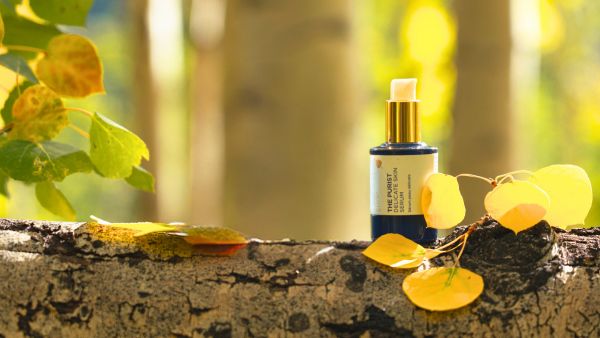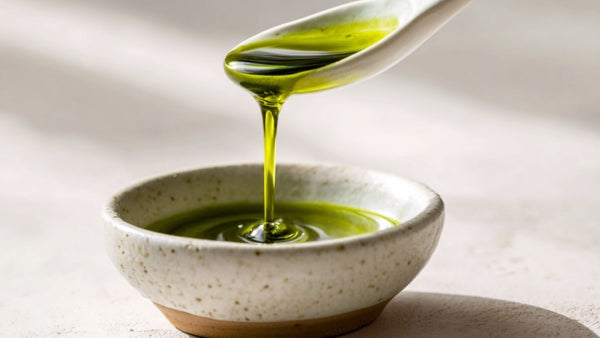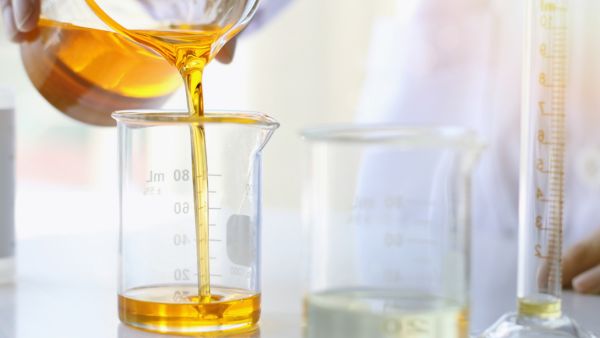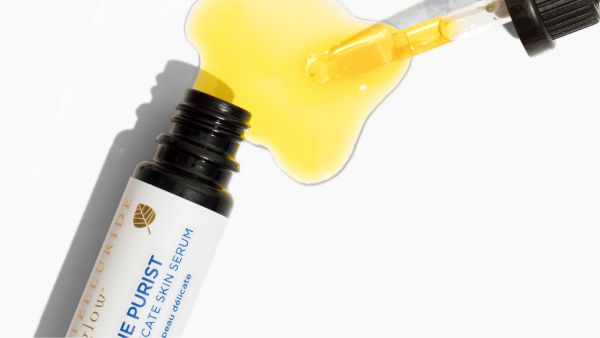Caring for Sensitive Skin
A sensitive skin care routine
Caring for sensitive skin can seem formidable. Potential irritants found in formulations can quickly cause delicate skin types to become reactive, so it pays to be discerning when curating the perfect skincare ritual.
We have put together the ultimate calming skincare ritual.
Let’s talk about sensitive skin
Our largest organ, the skin, protects us from environmental elements like UV rays, keeps out impurities, and helps regulate body temperature. The skin is an important part of our natural defense system, so it’s not surprising that it’s highly receptive to external and internal stressors.
Our body gives us signs when it’s not content with the status quo; an irritated, unsettled epidermis is a not-so-subtle message from our skin.
Pollutants, hormonal fluctuations, heat, environmental assault, allergens, and certain foods can all spark visible reactivity. Unfortunately, this response often leads to surface discomfort and aggravated skin.
In addition, psychological stress can heighten sensitive skin concerns, from hormonal breakouts to visible irritation. Stress activates the sympathetic nervous system and sets off processes that contribute to imbalance at the skin’s surface. These biological changes may disrupt the acid mantle, leaving skin more vulnerable and reactive.
An altered skin or gut microbiome can also tip normal skin into a delicate state. Because these systems are linked, a disruption in balance may contribute to heightened sensitivity.
Those with inherited sensitive skin may also be prone to redness and flushing. A sensitized skin is triggered by environmental factors, regardless of genetic predisposition.
Sensitive and sensitized skin has become increasingly common in our modern world. Our busy lifestyles and daily stress may be contributing factors. Identifying triggers, creating a nurturing skincare routine, and fortifying the skin barrier is the best way forward for compromised skin types.
Identify your sensitive skin triggers
When creating a routine for sensitive skin, the first step is to pinpoint potential irritants. Triggers can be different for everyone. Observing and removing any lifestyle or external stimuli such as certain foods, long hot showers, or aggravating ingredients can help calm reactive skin.
Alcohol and caffeine can encourage flushing, leading to surface redness. In addition, if you’re already prone to flare-ups, alcohol may intensify them. Heat also increases surface sensitivity. Hot water can create disruptions to the acid mantle, leaving the skin more vulnerable. Therefore, long hot showers should be avoided when caring for sensitive skin.
A high glycaemic diet can contribute to imbalance, sometimes showing up as visible skin changes. Food allergens may also trigger irritation.
Sensitizing ingredients in skincare can negatively alter the epidermal acid mantle by affecting cell alignment and increasing the likelihood of redness. In addition, irritating substances are processed by the skin’s defense cells, setting off visible surface reactions. Synthetic fragrance and parabens are common sensitive skin culprits.
Address an impaired barrier
Strengthening the skin’s acid mantle is essential when caring for sensitive skin. An impaired barrier may activate the skin’s defenses, resulting in the release of stress signals that show up as redness, irritation, or accelerated signs of aging.
Pure cold-pressed plant oils provide a protective veil and restore harmony for the skin. Sea buckthorn, jojoba, and hemp seed oils are rich in essential lipids, fatty acids, and phytonutrients to fortify the acid mantle.
These plant lipids also support the skin’s natural renewal process and help prevent moisture loss for a smooth, supple complexion. They act as natural soothers and are perfect for comforting sensitive skin.
We have combined these very plant oils with other organic whole-plant botanicals such as antioxidant-rich pomegranate and rosehip seed oil to create The Purist Delicate Skin Serum. This skin-strengthening serum is the perfect addition to your routine for sensitive skin.
Hydrate the skin
Hydrating ingredients are essential for quenching dull and lackluster skin or those exposed to environmental assault. Environmental factors may lead to an impaired barrier, trans-epidermal water loss (TEWL), and sensitivity. Caring for sensitive skin includes replenishing lost moisture alongside fortifying the acid mantle to create balance for depleted skin.
Skincare formulations containing hydrophilic ingredients offer crucial protection from accelerated surface damage and enhanced sensitivity.
Some prime hydrating candidates are micro-molecular hyaluronic acid, tremella polysaccharides, and phospholipids from shiitake and chamomile. These skin superheroes elevate precious moisture levels, plump the skin, and visibly smooth fine lines.
The Purist Delicate Skin Serum and the Aspen Dew Illuminating Essence are loaded with hydrating ingredients and high-altitude botanicals for luminous skin. The Purist Delicate Skin Serum is an antioxidant-packed nectar designed to fortify the skin barrier, while Aspen Dew Illuminating Essence hydrates, revitalizes, and gently brightens sensitive skin.
Seek out ultimate skin calmers
Look for skincare ingredients that soothe and pacify easily irritated skin.
-
Cloudberry seed oil acts as a natural comforter. It is also rich in protective nutrients like vitamin E. This precious oil offers skin barrier support through better alignment of epidermal cells, making this plant lipid a wonderful choice for sensitive skin.
-
Chamomile is a herbaceous bloom known for its calming ability. It has been used for centuries in traditional practices for its antioxidant and soothing qualities.
-
Arnica Montana flowers are described as nurturing and supportive, helping skin look more even and resilient.
-
Shavegrass (horsetail) is a potent alpine plant high in beneficial phytonutrients. Its comforting properties make it a perfect candidate for sensitive skin. It’s rich in flavonoids such as isoquercitrin, which helps to firm the appearance of sagging skin.
- Vitamin E is a soothing antioxidant and a time-honored nutrient that supports resilience. It also naturally preserves botanical oils, eliminating the need for parabens in conscientious skincare formulations.
-
Hemp seed oil is naturally abundant in essential fatty acids that replenish the skin’s surface and help maintain balance. Lightweight yet deeply nourishing, it supports a supple complexion and reinforces barrier strength.
- Aloe Vera not only drenches the skin in moisture but also provides refreshing comfort and nurtures a renewed appearance.
Gentle exfoliation
Although not recommended for highly aggravated skin, gentle exfoliation is beneficial for most complexions.
The Aspen Dew Illuminating Essence contains aspen bark, a plant-based exfoliator and brightening ingredient. This plant extract is a wonderful skin smoother and refresher for sensitive skin.
A thoughtful routine
Avoid key skin aggravators when curating your sensitive skin ritual. TellurideGlow products are vegan and cruelty-free. They’re free of synthetic colorants, artificial fragrances, and parabens — crafted for the well-being of your skin and the alpine landscapes that inspire us.















